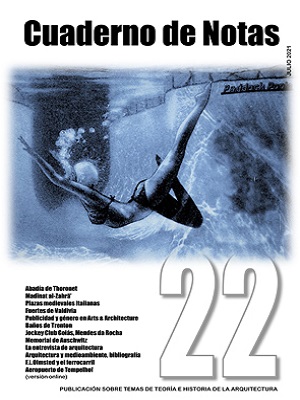Arquitectura singular y espacio público : in lexiones en la plaza medieval italiana = Unique architecture and public space : Inflections in the Italian medieval square
DOI:
https://doi.org/10.20868/cn.2021.4743Palabras clave:
Plaza, medievo, Italia, forma, espacio, urbanismo, square, Middle Ages, Italy, form, space, urban planningResumen
Resumen
La plaza medieval italiana, cuyo apogeo tiene lugar entre los siglos XIII y XIV e inmediatamente antes de la revolución que va a suponer el quattrocento, constituye uno de los espacios más interesantes de la historia del urbanismo y la arquitectura. Las características que estos conjuntos tienen en común, y las relaciones entre la arquitectura que los conforma y el propio espacio generado por ésta, se analizan aquí a partir de conceptos formales, simbólicos o puramente prácticos. El objetivo es poner de relieve la compleja relación entre la arquitectura singular y representativa presente en las plazas y el propio espacio urbano, señalando patrones, criterios y mecanismos comunes que ayuden a comprender su riqueza espacial y formal.
Abstract
The Italian medieval square, whose heyday takes place between the 13th and 14th centuries and immediately before the revolution that will bring about the quattrocento, is one of the most interesting spaces in history of architecture and urban planning. The characteristics that these ensembles have in common, and the relationships between the architecture that makes them up and the space generated by it, are analyzed here through formal, symbolic or purely practical concepts. The objective is to highlight the complex relationship between the singular and representative architecture present in the squares and the urban space itself, pointing out common patterns, criteria and mechanisms that help to understand their spatial and formal richness.
Descargas
Referencias
Brandi, Cesare. 1956. Eliante o dell’Architettura. Torino.
Favole, Paolo. 1972. Piazze d’Italia. Architettura e Urbanistica della Piazza in Italia. Milano: Bramante.
Gutkind, Erwin Anton. 1969. Urban Development in Southern Europe: Italy and Greece. New York: The Free Press.
Guidoni, Enrico. 1970. Arte e Urbanistica in Toscana. 1000-1315. Roma: Mario Bulzoni Editore.
Hilberseimer, Ludwig. 1955. The Nature of Cities. Chicago: Paul Theobald. (1969. La Natura delle Città. Milano).
Krier, Rob. 1975. Stadtraum in Theorie und Praxis. Stuttgart: Rob Krier (1981. El Espacio Urbano. Barcelona: Gustavo Gili).
Lugli, Piero Maria. 1967. Storia e Cultura della Città Italiana. Bari.
Morini, Mario. 1963. Atlante di Storia dell’Urbanistica. Milano: Ulrico Hoepli.
Norberg-Schulz, Christian. 1979a. Architettura Occidentale. Milano: Electa. (1983. Arquitectura Occidental. Barcelona: Gustavo Gili).
b. Genius Loci. Milano: Electa. (1980. Genius Loci. London: Academy Editions).
Architettura Barocca. Milano: Electa. (1989. Arquitectura Barroca. Madrid: Aguilar).
Sitte, Camillo. 1889. Der Städtebau nach seinen künstlerischen Grundsätzen. Viena. (1980. Camillo Sitte y el Nacimiento del Urbanismo Moderno. Construcción de Ciudades según Principios Artísticos. Barcelona: Gustavo Gili).
Venturi, Robert. 1966. Complexity and Contradiction in Architecture. New York: The Museum of Modern Art. (1978. Complejidad y contradicción en la Arquitectura.Barcelona: Gustavo Gili).
Zucker, Paul. 1959. Town and Square. New York: Columbia University Press. (1970. Town and Square. Cambridge-London: M.I.T. Press).
Google Maps: https://www.google.com/maps (figuras 4, 6 y 11)
Wikimedia Commons: https://commons.wikimedia. org (figuras 5, 7, 8, 10, 14, 15, 17-24)













